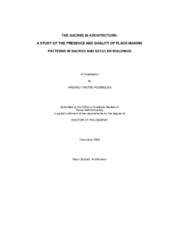| dc.contributor.advisor | Tabb, Phillip J. | |
| dc.creator | Rodrigues, Arsenio Timotio | |
| dc.date.accessioned | 2011-08-08T22:47:25Z | |
| dc.date.accessioned | 2011-08-09T01:33:43Z | |
| dc.date.available | 2011-08-08T22:47:25Z | |
| dc.date.available | 2011-08-09T01:33:43Z | |
| dc.date.created | 2008-12 | |
| dc.date.issued | 2009-05-15 | |
| dc.date.submitted | December 2008 | |
| dc.identifier.uri | https://hdl.handle.net/1969.1/ETD-TAMU-3103 | |
| dc.description.abstract | The purpose of this research is to expand knowledge regarding the presence and quality of
expression of certain place-making patterns that contribute to place being experienced as
sacred. The results are intended to validate and make available an assessment method based
on pattern presence and pattern quality for determining whether a specific built environment is
more likely to be experienced as sacred or secular. In addition, the results are intended to
provide architects with research-informed design guidelines for sacred place-making. This
research explores the difference in the presence and quality of expression of certain placemaking
patterns at two selected sacred and secular buildings, i.e., Rothko Chapel and
Contemporary Arts Museum, both in Houston, Texas.
Two key literature references were used as a basis for identifying place-making patterns used in
this research: 1) Sacred Place: The Presence of Archetypal Patterns in Place Creation, authored
by Phillip Tabb in 1996; and 2) Using the Place-Creation Myth to Develop Design Guidelines for
Sacred Space, authored by Michael Brill in 1985. Three types of data were collected and
analyzed: graphical data, questionnaire data, and focus group discussion data. Graphical data
included photographs and sketches with field notes. A total of forty-eight (48) questionnaires (24
at each setting) were administered to twenty-four (24) Houston architects at the selected
buildings. The focus group discussion panel consisted of 6 participants – three architects and
three spiritual mentors from Houston, Texas. Relative frequencies were calculated for multiplechoice
answers in the questionnaire, while open ended questionnaire items were subjected to
inductive content analysis. Focus group discussion data was examined and coded by means of
open coding, axial coding, and selective coding. The analyzed data were synthesized to test
whether the presence and quality of expression of certain place-making patterns contributed to
place being experienced as sacred.
This study concludes that built environments which possess a higher presence and higher
quality of expression of certain place-making patterns are more likely to be experienced as sacred than built environments with a lower presence and lower quality of expression of the
place-making patterns. A set of design guidelines for sacred place-making were produced and a
place-making pattern matrix was developed as part of this study. | en |
| dc.format.medium | electronic | en |
| dc.format.mimetype | application/pdf | |
| dc.language.iso | en_US | |
| dc.subject | Place-making Patterns; Pattern Language; Sacred Architecture; Sacred Buildings; | en |
| dc.title | The sacred in architecture: a study of the presence and quality of place-making patterns in sacred and secular buildings. | en |
| dc.type | Thesis | en |
| thesis.degree.department | Architecture | en |
| thesis.degree.discipline | Architecture | en |
| thesis.degree.grantor | Texas A&M University | en |
| thesis.degree.name | Doctor of Philosophy | en |
| thesis.degree.level | Doctoral | en |
| dc.contributor.committeeMember | Huang, Chang-Shan | |
| dc.contributor.committeeMember | Naderi, Jody R. | |
| dc.contributor.committeeMember | Shepley, Mardelle M. | |
| dc.type.genre | thesis | en |
| dc.type.material | text | en |
| dc.format.digitalOrigin | born digital | en |


